The 1950s Porsche Speedster is more than just a car; it’s an icon of automotive history that continues to captivate enthusiasts and collectors. The term “Speedster” refers to a model that Porsche designed to be both lightweight and high-performing, embodying the essence of a true sports car.
With its low-slung profile and minimalist design, the Speedster quickly became a symbol of both style and speed. Its introduction marked a significant moment for Porsche, as it established the brand’s presence in the highly competitive American sports car market.
The Speedster’s impact on the United States was profound, transforming the brand from a European niche player into a major contender in the American automotive scene.
Its affordability and performance made it accessible to a broader audience, allowing more people to experience the thrill of driving a Porsche. Ferdinand Porsche, the company’s founder, and his son Ferry Porsche, who was instrumental in the development of the Speedster, played crucial roles in its creation.
Their vision for a sports car that combined elegance with performance set the stage for the Speedster’s success. So, if you’re eager to learn more, scroll down!
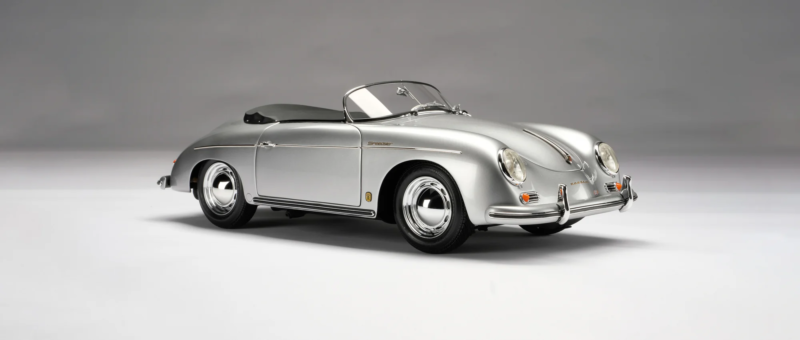
Credits: amalgamcollection.com
Key Takeaway
- The 1950s Porsche Speedster was a groundbreaking sports car that combined lightweight design, performance, and affordability, making a significant impact on the American automotive market.
- Its distinctive design features, including a low profile and minimalist aesthetic, set it apart from other cars of its era and continue influencing sports car design today.
- The Speedster underwent several evolutions during its production run, reflecting Porsche’s commitment to innovation and improvement in engineering and performance.
- The car’s legacy extends beyond its original production. It influences future Porsche models and maintains high value among collectors, and restoration efforts preserve its iconic status in automotive history.
The Birth of an Icon
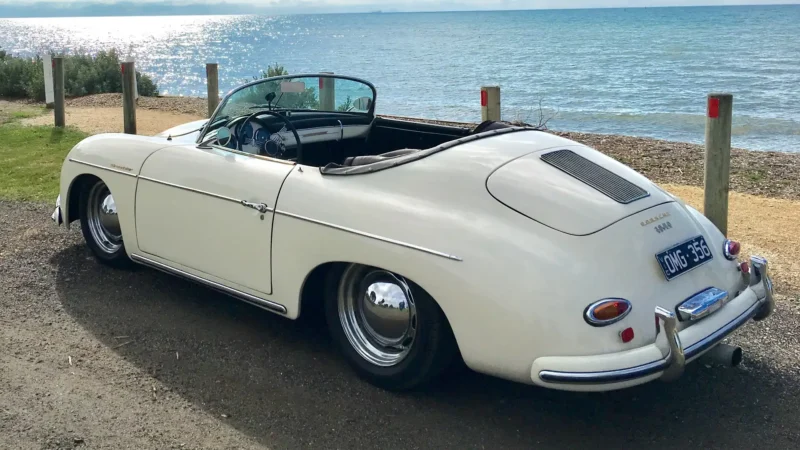
Credits: drive.com.au
The Porsche Speedster made its debut in 1954, marking the beginning of a new chapter in Porsche’s history.
This model responded to the increasing demand for sports cars in the United States, where Max Hoffman – Porsche’s US importer – saw an opportunity to introduce a more affordable variant of the Porsche 356.
Hoffman’s influence was pivotal. He convinced Porsche to create a car to attract American drivers seeking a thrilling and affordable sports car.
The Speedster was introduced as a more cost-effective, road-certified option than the standard Porsche 356, making it an attractive choice for those who desired a genuine sports car experience without the hefty price tag.
This strategic move allowed Porsche to tap into the American market more effectively, positioning the Speedster as an accessible yet desirable vehicle. The Porsche Speedster became an instant hit, solidifying the Porsche name in the American automotive landscape.
Design and Body Style
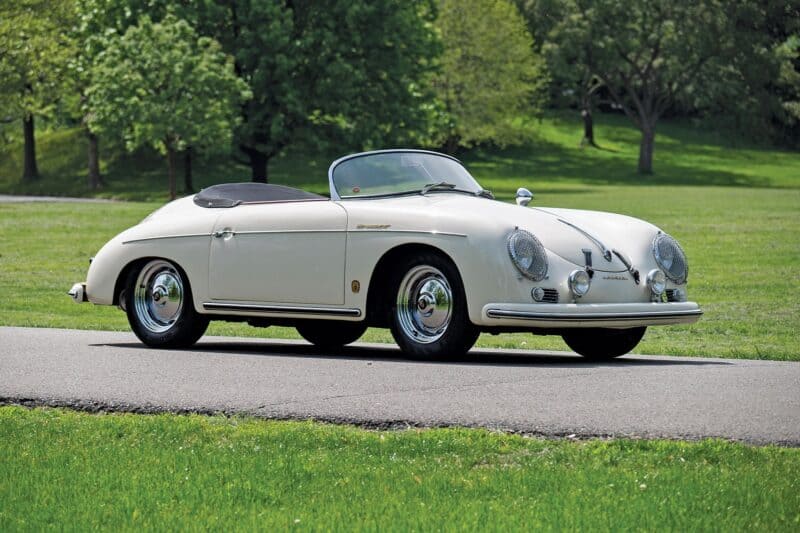
Source: sportscarmarket.com
The Porsche Speedster’s design was innovative and distinctive.
Its low, aerodynamic profile, raked windshield, and minimalist exterior set the Porsche 356 Speedster apart from other roadsters of the era.
The Speedster’s lightweight aluminum body contributed to its impressive performance and handling. The soft top and side curtains provided versatility and were designed to be easily removable, reflecting the car’s racing pedigree.
Inside, the Porsche 356 Speedster had lightweight bucket seats and a tonneau cover, adding to its sporty aesthetic.
The rear window design was another unique feature, designed to minimize drag and enhance the car’s aerodynamic efficiency.
This model was powered by a high-performance engine that replaced conventional designs, targeting the market for drivers seeking both style and substance. Porsche’s innovative approach with the Speedster solidified the company’s reputation in the automotive industry.
Compared to other classic cars, the Speedster’s emphasis on simplicity and performance was evident.
While modern cars have advanced significantly in terms of technology and comfort, the Speedster’s classic design continues to be celebrated for its purity and elegance.
Engineering and Performance

Credits: europeancollectibles.com
Under the hood, the Porsche Speedster boasted an impressive array of engineering features. Initially equipped with a 1500cc engine, the Speedster balanced power and efficiency. This was later upgraded to a 1600cc engine, providing even greater performance.
The manual transmission, a hallmark of Porsche engineering, allowed for precise control and an engaging driving experience.
One of the key innovations in the Speedster was the introduction of disc brakes in later models, which significantly improved braking performance.
With their lightweight aluminum body, the Pre-A versions of the Speedster set the stage for the future evolution of this iconic model.
The use of pushrod engines and roller-bearing crankshafts was also a notable feature, enhancing the car’s reliability and smoothness. The air-cooled engine, a signature of Porsche design, provided consistent performance and durability, even under demanding conditions.
The Speedster’s engineering was a testament to Porsche’s commitment to excellence, combining cutting-edge technology with a focus on driving enjoyment.
This blend of innovation and tradition ensured that the Speedster remained a high-performing sports car that appealed to both enthusiasts and casual drivers alike.
The Speedster in America
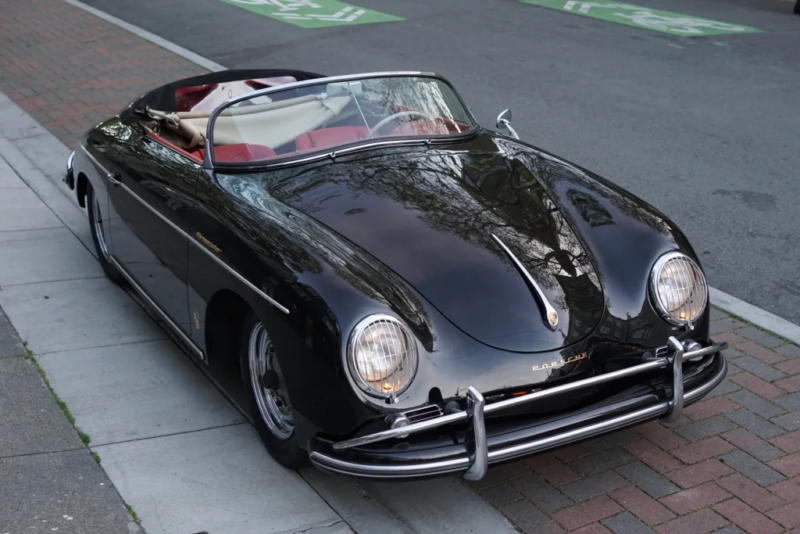
Credits: carplanet.com
The Porsche Speedster’s impact on the American market was nothing short of revolutionary.
Its arrival in the United States coincided with a growing interest in European sports cars like the Ferrari, and the Speedster quickly became a favorite among American drivers.
The car’s popularity was particularly pronounced in Southern California, where its sporty design and performance made it a symbol of the region’s vibrant automotive culture.
Famous owners like James Dean and Jerry Seinfeld further elevated the Speedster’s status, turning it into a cultural icon.
Dean, in particular, became associated with the Speedster after his tragic death, cementing the car’s place in American automotive lore. The Speedster was also a popular choice for weekend racing, with enthusiasts taking it to tracks like Mulholland Drive to test its limits and enjoy its spirited performance.
The Speedster’s success in America demonstrated the growing appetite for high-performance European sports cars and helped pave the way for other models and manufacturers to enter the US market.
Its profound influence on American car culture left a lasting legacy that continues to resonate with enthusiasts today.
Evolution of the Speedster
The Porsche Speedster underwent several updates throughout its production run, reflecting Porsche’s commitment to innovation and improvement.
The early models were known for their simplicity and lightweight construction, key factors in their performance. The Speedster evolved to include new features and enhancements as the years progressed.
One notable evolution was the introduction of the Convertible D in 1959, which offered a more comfortable ride and better weather protection compared to the original Speedster.
The Convertible D featured a more refined design, with a full convertible top that provided greater protection from the elements while maintaining the Speedster’s sporty character.
Another significant development was the Carrera Speedster, a high-performance variant with a more powerful engine and improved handling characteristics.
The Carrera Speedster built on the success of the original Speedster, offering an even more exhilarating driving experience. These evolutionary steps ensured that the Speedster remained competitive and desirable throughout its production, solidifying its reputation as one of Porsche’s most iconic models.
Collecting and Restoring 1950s Speedsters
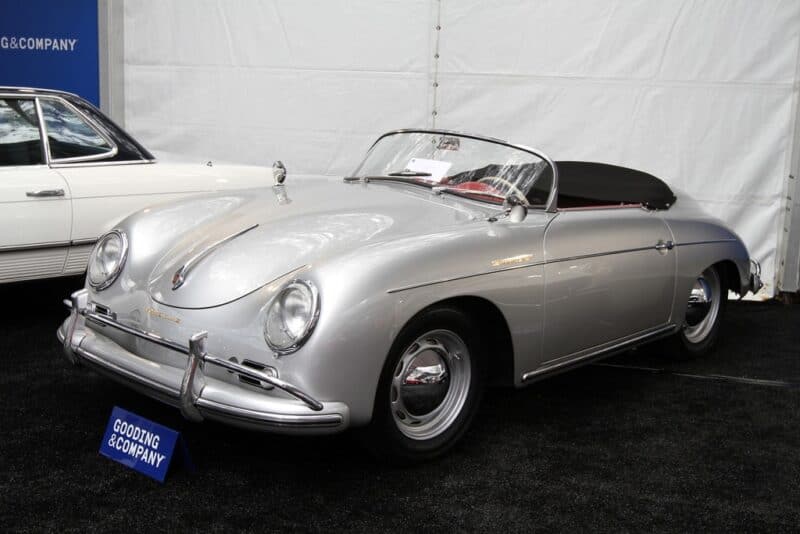
Credits: supercars.net
For car enthusiasts and collectors, the Porsche Speedster represents the pinnacle of classic sports car ownership.
Collecting and restoring a 1950s Speedster is a meticulous process that requires careful attention to detail and a deep appreciation for the car’s history. Authenticity is paramount, and the engine number and Porsche Certificate of Authenticity are crucial elements in verifying a car’s provenance.
Restoration of a Speedster involves a comprehensive process that includes sourcing original parts, restoring the car’s body and interior, and ensuring that the mechanical components are in top condition. Skilled craftsmen and specialists are often involved in this process, working to bring each Speedster back to its original glory. ‘
A fully restored Speedster in pristine condition can command impressive prices at auctions, reflecting its status as a highly sought-after classic.
The restoration of a Porsche Speedster is not just about preserving a car’s value; it’s also about preserving its legacy.
Enthusiasts who undertake this process often do so with a deep sense of respect for the car’s history and significance. This dedication ensures that the Speedster’s legacy continues to be celebrated and appreciated by future generations.
Legacy and Influence
The Porsche Speedster’s legacy extends well beyond its original production run.
Its design and engineering influenced future Porsche sports cars, which continue to draw inspiration from the Speedster’s blend of performance and style. Its success also led to the creation of replicas and modern interpretations, allowing new generations to experience its charm.
Modern Speedster replicas, while not identical to the original, capture the essence of its classic design and offer an affordable way for enthusiasts to enjoy a piece of automotive history.
The Porsche 911 Speedster, for example, pays homage to the original while incorporating contemporary technology and design. These modern versions highlight the Speedster’s enduring appeal and relevance in the world of sports cars.
The Speedster significantly impacted the 1950s automotive industry, showcasing the potential for a sports car to combine innovation, performance, and style. Its legacy reflects Porsche’s commitment to excellence and its ability to create vehicles that leave a lasting impression.
Conclusion: The Speedster’s Enduring Appeal
The 1950s Porsche Speedster is a beloved icon in the world of sports cars.
Its innovative design, exceptional performance, and cultural significance have made it a symbol of automotive excellence. The Speedster captures the spirit of its era while continuing to inspire new generations of car enthusiasts.
From its 1950s introduction to its lasting influence on modern sports cars, the Porsche Speedster is a milestone in automotive history.
Its place in Porsche’s legacy and the luxury sports car market is firmly established. The Speedster’s timeless design and performance ensure it will remain a cherished icon for years to come, a testament to the vision and craftsmanship of its creators.
